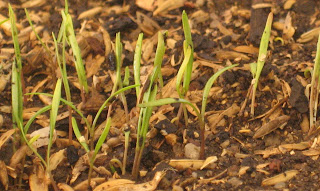 Following on from my previous post, here's a photo of the sweet corn and the maize. The sweet corn is on the lower left corner of the photo and as you can see, has not suffered damage due to the heat. The maize in the adjacent bed, however, is suffering quite a bit.
Following on from my previous post, here's a photo of the sweet corn and the maize. The sweet corn is on the lower left corner of the photo and as you can see, has not suffered damage due to the heat. The maize in the adjacent bed, however, is suffering quite a bit.The main difference is the preparation of the sweet corn bed before planting - it received a double dose of manure. Although I have watered the maize more than the sweet corn and given it seaweed extract, it is less resilient.
Clearly, bed preparation is going to be paramount in the years to come.
Despite the hot weather, it's not all bad around the garden at the moment. The elder has decided to have a second flush of flowers, reminding us that elderflower cordial is particularly cooling in the hot weather. The recipe I use is from Self-sufficientish. We've been enjoying this today, mixed with mineral water and ice.
 With the warmer weather, many seeds are ripening in the garden. This morning I collected a mix of broccoli, Brussels sprouts and cabbage seed, which I'm calling "brassica surprise"; mignonette lettuce seeds, carrot seeds, white beetroot seeds and calendula seeds.
With the warmer weather, many seeds are ripening in the garden. This morning I collected a mix of broccoli, Brussels sprouts and cabbage seed, which I'm calling "brassica surprise"; mignonette lettuce seeds, carrot seeds, white beetroot seeds and calendula seeds.All the seeds are looking very healthy, thanks no doubt to our little buzzy friends.
While watering the roses this morning, a thought popped into my head about planting lettuces between the roses. I consulted the companion planting books to find that mignonette lettuce make a great companion for roses, as do garlic and onions. Well, now I know where those lettuce seeds are going . . .
love and light
naturewitch




























